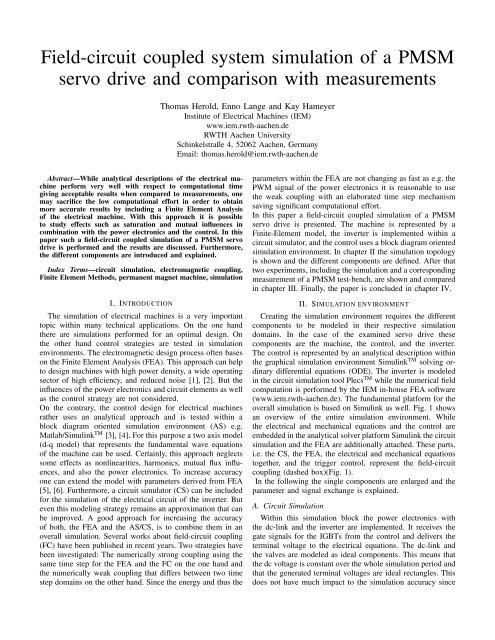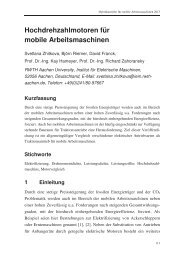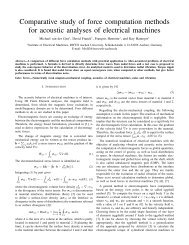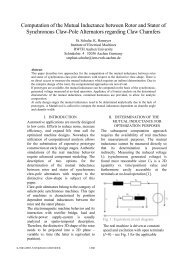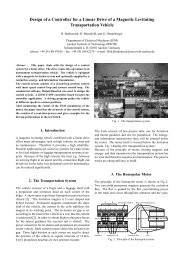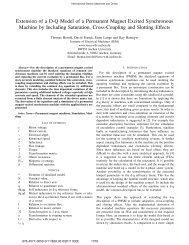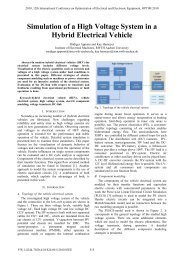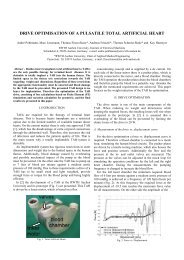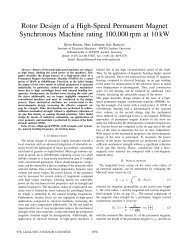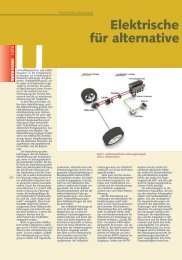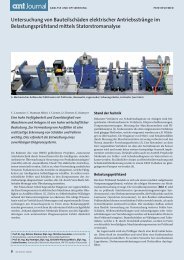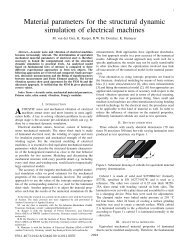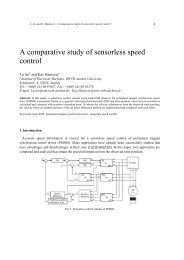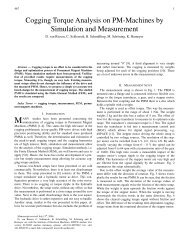Field-circuit coupled system simulation of a PMSM servo drive and ...
Field-circuit coupled system simulation of a PMSM servo drive and ...
Field-circuit coupled system simulation of a PMSM servo drive and ...
You also want an ePaper? Increase the reach of your titles
YUMPU automatically turns print PDFs into web optimized ePapers that Google loves.
<strong>Field</strong>-<strong>circuit</strong> <strong>coupled</strong> <strong>system</strong> <strong>simulation</strong> <strong>of</strong> a <strong>PMSM</strong><br />
<strong>servo</strong> <strong>drive</strong> <strong>and</strong> comparison with measurements<br />
Abstract—While analytical descriptions <strong>of</strong> the electrical machine<br />
perform very well with respect to computational time<br />
giving acceptable results when compared to measurements, one<br />
may sacrifice the low computational effort in order to obtain<br />
more accurate results by including a Finite Element Analysis<br />
<strong>of</strong> the electrical machine. With this approach it is possible<br />
to study effects such as saturation <strong>and</strong> mutual influences in<br />
combination with the power electronics <strong>and</strong> the control. In this<br />
paper such a field-<strong>circuit</strong> <strong>coupled</strong> <strong>simulation</strong> <strong>of</strong> a <strong>PMSM</strong> <strong>servo</strong><br />
<strong>drive</strong> is performed <strong>and</strong> the results are discussed. Furthermore,<br />
the different components are introduced <strong>and</strong> explained.<br />
Index Terms—<strong>circuit</strong> <strong>simulation</strong>, electromagnetic coupling,<br />
Finite Element Methods, permanent magnet machine, <strong>simulation</strong><br />
I. INTRODUCTION<br />
The <strong>simulation</strong> <strong>of</strong> electrical machines is a very important<br />
topic within many technical applications. On the one h<strong>and</strong><br />
there are <strong>simulation</strong>s performed for an optimal design. On<br />
the other h<strong>and</strong> control strategies are tested in <strong>simulation</strong><br />
environments. The electromagnetic design process <strong>of</strong>ten bases<br />
on the Finite Element Analysis (FEA). This approach can help<br />
to design machines with high power density, a wide operating<br />
sector <strong>of</strong> high efficiency, <strong>and</strong> reduced noise [1], [2]. But the<br />
influences <strong>of</strong> the power electronics <strong>and</strong> <strong>circuit</strong> elements as well<br />
as the control strategy are not considered.<br />
On the contrary, the control design for electrical machines<br />
rather uses an analytical approach <strong>and</strong> is tested within a<br />
block diagram oriented <strong>simulation</strong> environment (AS) e.g.<br />
Matlab/Simulink TM [3], [4]. For this purpose a two axis model<br />
(d-q model) that represents the fundamental wave equations<br />
<strong>of</strong> the machine can be used. Certainly, this approach neglects<br />
some effects as nonlinearities, harmonics, mutual flux influences,<br />
<strong>and</strong> also the power electronics. To increase accuracy<br />
one can extend the model with parameters derived from FEA<br />
[5], [6]. Furthermore, a <strong>circuit</strong> simulator (CS) can be included<br />
for the <strong>simulation</strong> <strong>of</strong> the electrical <strong>circuit</strong> <strong>of</strong> the inverter. But<br />
even this modeling strategy remains an approximation that can<br />
be improved. A good approach for increasing the accuracy<br />
<strong>of</strong> both, the FEA <strong>and</strong> the AS/CS, is to combine them in an<br />
overall <strong>simulation</strong>. Several works about field-<strong>circuit</strong> coupling<br />
(FC) have been published in recent years. Two strategies have<br />
been investigated: The numerically strong coupling using the<br />
same time step for the FEA <strong>and</strong> the FC on the one h<strong>and</strong> <strong>and</strong><br />
the numerically weak coupling that differs between two time<br />
step domains on the other h<strong>and</strong>. Since the energy <strong>and</strong> thus the<br />
Thomas Herold, Enno Lange <strong>and</strong> Kay Hameyer<br />
Institute <strong>of</strong> Electrical Machines (IEM)<br />
www.iem.rwth-aachen.de<br />
RWTH Aachen University<br />
Schinkelstraße 4, 52062 Aachen, Germany<br />
Email: thomas.herold@iem.rwth-aachen.de<br />
parameters within the FEA are not changing as fast as e.g. the<br />
PWM signal <strong>of</strong> the power electronics it is reasonable to use<br />
the weak coupling with an elaborated time step mechanism<br />
saving significant computational effort.<br />
In this paper a field-<strong>circuit</strong> <strong>coupled</strong> <strong>simulation</strong> <strong>of</strong> a <strong>PMSM</strong><br />
<strong>servo</strong> <strong>drive</strong> is presented. The machine is represented by a<br />
Finite-Element model, the inverter is implemented within a<br />
<strong>circuit</strong> simulator, <strong>and</strong> the control uses a block diagram oriented<br />
<strong>simulation</strong> environment. In chapter II the <strong>simulation</strong> topology<br />
is shown <strong>and</strong> the different components are defined. After that<br />
two experiments, including the <strong>simulation</strong> <strong>and</strong> a corresponding<br />
measurement <strong>of</strong> a <strong>PMSM</strong> test-bench, are shown <strong>and</strong> compared<br />
in chapter III. Finally, the paper is concluded in chapter IV.<br />
II. SIMULATION ENVIRONMENT<br />
Creating the <strong>simulation</strong> environment requires the different<br />
components to be modeled in their respective <strong>simulation</strong><br />
domains. In the case <strong>of</strong> the examined <strong>servo</strong> <strong>drive</strong> these<br />
components are the machine, the control, <strong>and</strong> the inverter.<br />
The control is represented by an analytical description within<br />
the graphical <strong>simulation</strong> environment Simulink TM solving ordinary<br />
differential equations (ODE). The inverter is modeled<br />
in the <strong>circuit</strong> <strong>simulation</strong> tool Plecs TM while the numerical field<br />
computation is performed by the IEM in-house FEA s<strong>of</strong>tware<br />
(www.iem.rwth-aachen.de). The fundamental platform for the<br />
overall <strong>simulation</strong> is based on Simulink as well. Fig. 1 shows<br />
an overview <strong>of</strong> the entire <strong>simulation</strong> environment. While<br />
the electrical <strong>and</strong> mechanical equations <strong>and</strong> the control are<br />
embedded in the analytical solver platform Simulink the <strong>circuit</strong><br />
<strong>simulation</strong> <strong>and</strong> the FEA are additionally attached. These parts,<br />
i.e. the CS, the FEA, the electrical <strong>and</strong> mechanical equations<br />
together, <strong>and</strong> the trigger control, represent the field-<strong>circuit</strong><br />
coupling (dashed box)(Fig. 1).<br />
In the following the single components are enlarged <strong>and</strong> the<br />
parameter <strong>and</strong> signal exchange is explained.<br />
A. Circuit Simulation<br />
Within this <strong>simulation</strong> block the power electronics with<br />
the dc-link <strong>and</strong> the inverter are implemented. It receives the<br />
gate signals for the IGBTs from the control <strong>and</strong> delivers the<br />
terminal voltage to the electrical equations. The dc-link <strong>and</strong><br />
the valves are modeled as ideal components. This means that<br />
the dc voltage is constant over the whole <strong>simulation</strong> period <strong>and</strong><br />
that the generated terminal voltages are ideal rectangles. This<br />
does not have much impact to the <strong>simulation</strong> accuracy since
CS<br />
Circuit<br />
<strong>simulation</strong><br />
control<br />
Electrical<br />
equations<br />
Trigger<br />
control<br />
AS<br />
Fig. 1. The overall <strong>simulation</strong> environment.<br />
FEA<br />
<strong>Field</strong><br />
<strong>simulation</strong><br />
Mechanical<br />
equations<br />
the dc link voltage <strong>of</strong> the used inverter is controlled to a fix<br />
value which exceeds the semiconductor voltage drop by orders.<br />
Contrary to this idealization the IGBT timings are included to<br />
simulate the blanking time <strong>of</strong> the inverter which is to protect<br />
the inverter legs against a “shoot through”. This blanking time<br />
causes a nonlinear relationship between the duty cycle <strong>and</strong><br />
the average output voltage. For the accuracy <strong>of</strong> the overall<br />
<strong>simulation</strong> it is important to identify the dead-time <strong>of</strong> the<br />
used inverter. Therefore, two inverter legs are fed with a duty<br />
cycle <strong>of</strong> 50% whereas the third one is continuously increased<br />
from 0.35 to 0.65 within 15 s. With this slow increase an<br />
approximated steady-state motor current for each adjusted duty<br />
cycle is guaranteed. The result <strong>of</strong> this experiment (current vs.<br />
duty cycle) is shown in Fig. 2 (lower picture). It can be seen<br />
that there is a dead b<strong>and</strong> between approx. a1 = 0.42 <strong>and</strong><br />
a2 = 0.58. The blanking time can now be calculated by<br />
∆V T<br />
Td =<br />
2VDC<br />
= a2 − a1<br />
2<br />
T<br />
VDC<br />
2VDC<br />
= a2 − a1<br />
4<br />
· T (1)<br />
with the voltage deviation ∆V , the dc-link voltage VDC, <strong>and</strong><br />
the length <strong>of</strong> one PWM cycle T [7]. For a PWM frequency<br />
<strong>of</strong> 8 kHz Td is determined to 5 µs. The upper picture <strong>of</strong> Fig. 2<br />
shows a <strong>simulation</strong> result with an included Td. Although the<br />
measured current is more round shaped in the transition region<br />
the basic pr<strong>of</strong>ile is reflected.<br />
i 1 [A]<br />
i 1 [A]<br />
40<br />
20<br />
0<br />
−20<br />
<strong>simulation</strong><br />
−40<br />
0.3 0.35 0.4 0.45 0.5 0.55 0.6 0.65 0.7<br />
40<br />
20<br />
0<br />
−20<br />
measurement<br />
−40<br />
0.3 0.35 0.4 0.45 0.5 0.55 0.6 0.65 0.7<br />
duty cycle (phase 1)<br />
Fig. 2. Simulated <strong>and</strong> measured inverter dead-time behavior.<br />
B. Lumped parameter extraction from FEA<br />
Whenever the trigger control sends a signal, a new set <strong>of</strong><br />
lumped parameters must be extracted from the FE model. For<br />
the device under test, a continuous evaluation <strong>of</strong> the energy<br />
flows <strong>of</strong> the electrical as well as the mechanical domain<br />
ensures a smooth extraction <strong>of</strong> the parameters, which is based<br />
on the balance <strong>of</strong> energy <strong>of</strong> the electrical machine, as presented<br />
in [8]. The three-phase <strong>PMSM</strong> is represented by an induction<br />
matrix L ∂ kl<br />
<strong>of</strong> self <strong>and</strong> mutual inductances with dimension 3x3<br />
<strong>and</strong> a vector <strong>of</strong> motion induced voltages ek with dimension<br />
three. The flux induced voltage <strong>of</strong> phase k is given by the time<br />
derivative <strong>of</strong> the flux linkage ψk (with implicit summation<br />
over l) as the difference <strong>of</strong> the terminal voltage vk <strong>and</strong> the<br />
ohmic voltage drop Rik:<br />
∂tψk = vk − Rik = ∂tψkl + ∂tψf,k . (2)<br />
Herein, ψf,k = f(α) is the remanence flux embraced by the<br />
permanent magnets being a function <strong>of</strong> the angular position <strong>of</strong><br />
the rotor α = f(t), <strong>and</strong> ψkl = f(α, il) is the flux linkage in<br />
phase k depending on the current il = f(t) carried by phase l<br />
<strong>and</strong> the rotor position α. Propagating the differential operator<br />
in (2), one yields:<br />
∂tψk = ∂t(Lklil) + ∂tψf,k<br />
= (∂tLkl) il + Lkl (∂til) + ∂tψf,k<br />
= (∂til∂il Lkl) il + ω (∂αLkl) il + Lkl (∂til) + ∂tψf,k<br />
= ∂til ((∂il Lkl)il + Lkl) + ω(∂αLkl)il + ω∂αψf,k<br />
= (∂til) L ∂ kl + ω∂αψk = (∂til) L ∂ kl + ωe ∗ k<br />
The first term <strong>of</strong> (3) expresses the induced voltage by the flux<br />
linkage described by the inductance matrix L∂ kl <strong>and</strong> the second<br />
term the motion induced voltage with the speed normalized<br />
electromotive force (emf) e∗ k . These parameters are given to<br />
the electrical equations where the corresponding line currents<br />
are calculated which are sent back to the field <strong>simulation</strong><br />
afterwards.<br />
C. Trigger control<br />
The trigger control is an important aspect <strong>of</strong> the field<strong>circuit</strong><br />
<strong>coupled</strong> <strong>simulation</strong>. Herein, the time step <strong>of</strong> the FEA<br />
is determined. The implemented FC is based on the weak<br />
coupling implying different steps for the <strong>circuit</strong> <strong>simulation</strong>s<br />
<strong>and</strong> the FEA. This may save a lot <strong>of</strong> computational effort since<br />
the time constant <strong>of</strong> the field domain τF EA usually exceeds the<br />
time constant <strong>of</strong> the <strong>circuit</strong> domain τAS by orders <strong>of</strong> magnitude<br />
<strong>and</strong> thus the relation for the time steps is ∆TF EA >> ∆TAS.<br />
The simplest approach for trigger generation is using a fixed<br />
step size. But if e.g. the currents are changing relatively fast,<br />
the lumped parameter representation <strong>of</strong> the machine would<br />
change significantly, especially if the machine operates in<br />
saturation. On the contrary, if the operating point is not or even<br />
slowly changing, an unnecessary, time consuming, extraction<br />
<strong>of</strong> a new set <strong>of</strong> lumped parameters may be forced.<br />
A more reasonable approach is to adapt the time step. This<br />
can be done by energy considerations. Whenever the energy in<br />
the <strong>system</strong> is changing by a certain amount the trigger control<br />
enforces an extraction <strong>of</strong> a new set <strong>of</strong> lumped parameters from<br />
.<br />
(3)
the FEA. The energy in the <strong>system</strong> is subdivided in four parts,<br />
which are calculated as follows (with implicit summation<br />
over k).<br />
The electrical energy is given by the terminal values vk <strong>and</strong> ik:<br />
<br />
Eelec = vkikdt . (4)<br />
The ohmic losses <strong>of</strong> the windings have to be considered as<br />
well:<br />
<br />
Eohmic = R i 2 kdt . (5)<br />
The energy<br />
Emag = 1<br />
2 ikψk = 1<br />
2 ik<br />
<br />
(vk − Rik − ωe ∗ k)dt (6)<br />
represents the magnetic energy stored in the field <strong>of</strong> the machine’s<br />
coils. The mechanical energy is calculated by rotational<br />
speed <strong>and</strong> torque:<br />
<br />
Emech = ωT dt . (7)<br />
A new trigger signal is now generated at the time t1 > t0<br />
<strong>of</strong> the last valid parameter extraction when the overall energy<br />
Etot = E changes by a given specific threshold p, e.g.<br />
p = 5%:<br />
(8)<br />
with<br />
<strong>and</strong><br />
t1 = t0 + ∆TF EA<br />
∆TF EA = t| (etot≥p) − t0<br />
etot = Etot(t)<br />
Etot(t0)<br />
(9)<br />
. (10)<br />
To ensure that position dependent influences are not neglected<br />
if the energy change remains below p, an additional<br />
trigger condition for the position is applied<br />
∆TF EA = t| (∆α≥α0) − t0<br />
(11)<br />
where ∆α = α(t) − α(t0) is the change <strong>of</strong> the rotor position<br />
<strong>and</strong> α0 a predefined difference angle. After a trigger signal<br />
has been sent the time t0 is set to the new time t1.<br />
To get an idea <strong>of</strong> the computational effort: 1 s <strong>simulation</strong><br />
means 5 min computational time with an analytical machine<br />
representation <strong>and</strong> 24 h with the numerical machine representation<br />
at weak coupling with p = 0.05 <strong>and</strong> α0 = 2 ◦ .<br />
D. Electrical <strong>and</strong> mechanical equations<br />
Electrical equations: Two designs for the calculation the<br />
motor currents are feasible. The first one is the determination<br />
<strong>of</strong> the currents outside the CS generating a signal given to<br />
signal controlled current sources within the CS. The terminal<br />
voltages <strong>of</strong> the machine are the voltages over these current<br />
sources. The second design is the modeling <strong>of</strong> the motor<br />
inductance, resistance, <strong>and</strong> induced voltage directly within the<br />
CS. For this purpose the <strong>simulation</strong> s<strong>of</strong>tware has to provide<br />
controllable mutual inductances.<br />
For this work the first alternative is used. Therefore, the line<br />
Fig. 3. Reducing <strong>of</strong> <strong>circuit</strong> elements to solve overdetermination.<br />
currents <strong>of</strong> the machine are calculated by (2) <strong>and</strong> (3) after<br />
being transformed to<br />
i = (L ∂ ) −1<br />
<br />
(v − Ri − ωe ∗ )dt . (12)<br />
Since there is no zero phase-sequence <strong>system</strong>, the current<br />
equation above is overdetermined if solved independently for<br />
each phase. To solve this overdetermination the <strong>system</strong> is<br />
transformed as shown in Fig. 3. Now, only two phase currents<br />
are calculated whereas the third is given by Kirchh<strong>of</strong>f‘s law.<br />
This is implemented within the <strong>simulation</strong> block “Electrical<br />
equations”. The currents are sent back to the <strong>circuit</strong> simulator’s<br />
signal controlled current sources <strong>and</strong> given to the FEA as well.<br />
They can be written as<br />
<br />
l3<br />
i1 =<br />
(A −<br />
l1l3 − l2l4<br />
l2<br />
B)dt<br />
l3<br />
<br />
l1<br />
i3 =<br />
(B − l1<br />
(13)<br />
A)dt<br />
l1l3 − l2l4<br />
with the abbreviations<br />
A := v1 − v2 − e1 + e2 − R(2i1 + i3)<br />
B := v3 − v2 − e3 + e2 − R(2i3 + i1)<br />
l1 := L ∂ 11 − L ∂ 21 − L ∂ 12 + L ∂ 22<br />
l2 := L ∂ 13 − L ∂ 23 − L ∂ 12 + L ∂ 22<br />
l4<br />
l3 := L ∂ 33 − L ∂ 23 − L ∂ 32 + L ∂ 22<br />
l4 := L ∂ 31 − L ∂ 21 − L ∂ 32 + L ∂ 22 .<br />
(14)<br />
Mechanical equations: As aforementioned, the time steps<br />
<strong>of</strong> the FEA <strong>and</strong> the AS are different. Therefore, it is necessary<br />
to calculate the speed ω <strong>and</strong> position angle α <strong>of</strong> the machine<br />
outside the FEA to obtain a smooth curve. This is done by the<br />
mechanical equations<br />
ω = 1<br />
<br />
(Tel − Tload − Tloss)dt<br />
<br />
J<br />
(15)<br />
α = ωdt
where J is the moment <strong>of</strong> inertia, Tel the electromagnetic<br />
torque <strong>of</strong> the machine, Tload the machine’s load, <strong>and</strong> Tloss<br />
the speed dependent losses. The electrical torque is calculated<br />
by the FEA which in turn is fed by the phase currents <strong>and</strong> the<br />
rotor position α.<br />
E. Control<br />
Operating a <strong>PMSM</strong> <strong>servo</strong> commonly requires a closed loop<br />
control. Here, we use a PI cascade with an inner current<br />
<strong>and</strong> an outer speed control. The current control consists <strong>of</strong><br />
two PI controllers responsible for the d- <strong>and</strong> the q-current<br />
respectively. They are designed as zero-pole compensation<br />
with a reduction <strong>of</strong> the effective time constant to a fifth <strong>of</strong><br />
the natural one. To assist the controllers a subsequent static<br />
decoupling network compensating the axis cross-coupling <strong>and</strong><br />
the induced voltage is added [9]. The speed control only<br />
consists <strong>of</strong> a proportional part to avoid overshoots leading to<br />
oscillation that will increase the experiment time since they<br />
have to be decayed for a steady-state analysis. The duty cycles<br />
for the PWM are generated by a space vector modulation<br />
(SVM) [10].<br />
III. EXPERIMENT RESULTS<br />
With the described <strong>simulation</strong> environment two experiments,<br />
including a <strong>simulation</strong> <strong>and</strong> a corresponding measurement,<br />
are performed <strong>and</strong> compared: a startup <strong>of</strong> a machine<br />
<strong>and</strong> a steady-state load scenario. The device under test is a<br />
<strong>PMSM</strong> <strong>servo</strong> <strong>coupled</strong> to a load machine. In Tab. I some data<br />
<strong>of</strong> the <strong>PMSM</strong> are given. The machine has an almost sinusoidal<br />
Stator + cable resistance (measured) R 0.9 Ω<br />
Inductance (direct axis - data sheet) Ld 0.6 mH<br />
Inductance (quadrature axis - data sheet) Lq 0.6 mH<br />
Mass <strong>of</strong> inertia (overall <strong>drive</strong> train) J 2.69 kgcm 2<br />
Number <strong>of</strong> pole pairs p 3<br />
Nominal torque TN 8.4 Nm<br />
Nominal current IN 9.3 A<br />
Max. avg. tooth flux density (zero current-FEA) Bm0 1.7 T<br />
TABLE I<br />
DATA OF THE DEVICE UNDER TEST.<br />
induced voltage, only little position dependent inductance deviations,<br />
<strong>and</strong> a small cogging torque. Therefore, the influence<br />
<strong>of</strong> this parameters to the current waveform are negligible <strong>and</strong><br />
thus the influence <strong>of</strong> the voltage switching semiconductors <strong>and</strong><br />
the inverter dead time are good observable. Only the saturation<br />
<strong>of</strong> the machine has a significant influence to the experiments.<br />
In the area <strong>of</strong> operation <strong>of</strong> the experiments explained in this<br />
paper the saturation state <strong>of</strong> the machine is almost constant but<br />
the inductances are differing considerably to the ones given in<br />
the data sheet. This influence was investigated in a previous<br />
work [11].<br />
A. Startup operation<br />
For the startup the load machine is in no load condition<br />
that only the mass <strong>of</strong> inertia <strong>and</strong> the losses have to be compensated.<br />
For proper <strong>simulation</strong> conditions the losses basing<br />
on friction <strong>and</strong> eddy-currents are determined by measurements<br />
<strong>of</strong> the transferred torque at no-load. In Fig. 4 the machine’s<br />
speed <strong>of</strong> the <strong>simulation</strong> <strong>and</strong> the measurement is shown. The<br />
speed [1/rad]<br />
speed [1/rad]<br />
200<br />
150<br />
100<br />
50<br />
<strong>simulation</strong><br />
0<br />
0 0.05 0.1 0.15 0.2 0.25 0.3 0.35 0.4 0.45 0.5<br />
200<br />
150<br />
100<br />
50<br />
measurement<br />
0<br />
0 0.05 0.1 0.15 0.2 0.25<br />
time [s]<br />
0.3 0.35 0.4 0.45 0.5<br />
Fig. 4. Startup operation - speed.<br />
quantization noise <strong>of</strong> the speed is caused by the incremental<br />
position encoder with a resolution <strong>of</strong> 4096 per turn, which is<br />
also simulated. However, this speed curves do not tell much<br />
about the quality <strong>of</strong> the <strong>simulation</strong> <strong>and</strong> a closer look to the<br />
stator currents is given in Fig. 5. Here, it can be seen that<br />
the startup operation within the <strong>simulation</strong> is faster than the<br />
measurement which bases on a minor difference in the mass<br />
<strong>of</strong> inertia or the developed torque. The effect <strong>of</strong> the inverter<br />
becomes visible in the current waveform that differ from an<br />
ideal sinusoidal shape.<br />
B. Steady-state load operation<br />
For a further investigation <strong>of</strong> the current waveforms an<br />
experiment with a steady-state load <strong>of</strong> 0.7 · TN is performed.<br />
The simulated <strong>and</strong> measured currents are shown in Fig. 6.<br />
Here, the harmonic distortion is clearly observable. A better<br />
impression about the harmonic content gives an FFT <strong>of</strong> the<br />
currents, shown in Fig. 7. For a better resolution <strong>of</strong> the harmonic<br />
frequencies the fundamental wave (≈ 9 A) is truncated.<br />
One can see the PWM influence at 4 <strong>and</strong> 8 kHz <strong>and</strong> some<br />
current i 1 [A]<br />
current i 1 [A]<br />
20<br />
10<br />
0<br />
−10<br />
<strong>simulation</strong><br />
−20<br />
0 0.05 0.1 0.15 0.2 0.25 0.3 0.35 0.4 0.45 0.5<br />
20<br />
10<br />
0<br />
−10<br />
measurement<br />
−20<br />
0 0.05 0.1 0.15 0.2 0.25<br />
time [s]<br />
0.3 0.35 0.4 0.45 0.5<br />
Fig. 5. Startup operation - currents.
current i 1 [A]<br />
current i 1 [A]<br />
20<br />
10<br />
0<br />
−10<br />
<strong>simulation</strong><br />
−20<br />
0 0.005 0.01 0.015 0.02 0.025 0.03 0.035 0.04 0.045 0.05<br />
20<br />
10<br />
0<br />
−10<br />
measurement<br />
−20<br />
0 0.005 0.01 0.015 0.02 0.025<br />
time [s]<br />
0.03 0.035 0.04 0.045 0.05<br />
Fig. 6. Load operation - currents.<br />
peaks below 2 kHz representing the 5th, 7th, 11th, 13th,....<br />
harmonic that occur at operation with SVM <strong>and</strong> inverter deadtimes<br />
[12]. Although the frequencies are exactly reproduced by<br />
the <strong>simulation</strong>, the amplitudes <strong>of</strong> the harmonics show partially<br />
differences about ≈ 30%. This indicates that the modeling <strong>of</strong><br />
the inverter is not sufficient yet. Moreover, the SVM dependent<br />
harmonics have a phase difference <strong>of</strong> 180 ◦ which can be seen<br />
in the current plot. This also shows the inadequate inverter<br />
representation.<br />
IV. DISCUSSION AND CONCLUSIONS<br />
In this paper a weak <strong>coupled</strong> field-<strong>circuit</strong> <strong>simulation</strong> <strong>of</strong> a<br />
<strong>PMSM</strong> <strong>servo</strong> is presented combining a <strong>circuit</strong> <strong>simulation</strong> for<br />
the power electronics, a numerical field <strong>simulation</strong> for the<br />
machine <strong>and</strong> a machine control. All different components are<br />
explained with the focus on the lumped parameter extraction<br />
<strong>of</strong> the FEA, the trigger control for an extraction <strong>of</strong> a new set<br />
<strong>of</strong> lumped parameters, <strong>and</strong> the prerequisites for coupling the<br />
FEA to the FC <strong>and</strong> AS. Furthermore, <strong>simulation</strong> results <strong>and</strong><br />
measurements are presented <strong>and</strong> compared showing promising<br />
FFT(i 1 ) [A]<br />
FFT(i 1 ) [A]<br />
0.5<br />
0.4<br />
0.3<br />
0.2<br />
0.1<br />
<strong>simulation</strong><br />
0<br />
0 1000 2000 3000 4000 5000 6000 7000 8000 9000 10000<br />
0.5<br />
0.4<br />
0.3<br />
0.2<br />
0.1<br />
measurement<br />
0<br />
0 1000 2000 3000 4000 5000 6000 7000 8000 9000 10000<br />
frequency [Hz]<br />
Fig. 7. Load operation - FFT analysis <strong>of</strong> currents.<br />
results. At first it can be summarized that the basic concept<br />
behind the presented field-<strong>circuit</strong> coupling is proven. A stable<br />
numerical <strong>simulation</strong> could be reached that shows a good<br />
correlation to measurement. Although the time characteristics<br />
(<strong>simulation</strong> <strong>and</strong> measurement) <strong>of</strong> the experiments are quite<br />
similar there are however notable deviations. At first the<br />
harmonic amplitudes are differing about ≈30%. Moreover,<br />
the inverter induced harmonics show different algebraic signs<br />
which also indicates a insufficient inverter modeling. Therefore,<br />
further investigations will focus on the power electronics<br />
to get a more precise representation on the one h<strong>and</strong>. On<br />
the other h<strong>and</strong> a machine with distinctive position depended<br />
inductances (e.g. a switched reluctance machine) will be<br />
investigated to get more information about the the accuracy<br />
<strong>of</strong> the field solution.<br />
REFERENCES<br />
[1] Chao-hui Zhao; Haihong Qin; Yang-guang Yan; , ”Analysis <strong>of</strong> the Pole<br />
Numbers on Flux <strong>and</strong> Power Density <strong>of</strong> IPM Synchronous Machine,”<br />
Power Electronics <strong>and</strong> Drives Systems, 2005. PEDS 2005. International<br />
Conference on , vol.2, pp.1402-1407.<br />
[2] Franck, David; Hameyer, K.; , ”Simulation <strong>of</strong> Acoustic Radiation <strong>of</strong> an<br />
AC Servo Drive Verified by Measurements,” International Symposium on<br />
electromagnetic fields , ISEF 2009.<br />
[3] Rujing Xiao; Xiangyu Yang; Wenjuan Zhu; Jianghua Cao; , ”Modeling<br />
<strong>and</strong> <strong>simulation</strong> <strong>of</strong> dual-rotor permanent-magnet synchronous motor based<br />
on MATLAB,” Electrical Machines <strong>and</strong> Systems, 2009. ICEMS 2009.<br />
International Conference on , pp.1-4, 15-18 Nov. 2009.<br />
[4] Iyer, N.P.R.; Jianguo Zhu; , ”Modeling <strong>and</strong> Simulation <strong>of</strong> A Six Step Discontinuous<br />
Current Mode Inverter Fed Permanent Magnet Synchronous<br />
Motor Drive Using SIMULINK,” Power Electronics <strong>and</strong> Drives Systems,<br />
2005. PEDS 2005. International Conference on , vol.2, pp. 1056- 1061,<br />
28-01 Nov. 2005.<br />
[5] Petkovska, L.; Cvetkovski, G.; , ”FEM Based Simulation <strong>of</strong> a Permanent<br />
Magnet Synchronous Motor Performance Characteristics,” Power Electronics<br />
<strong>and</strong> Motion Control Conference, 2006. IPEMC 2006. CES/IEEE<br />
5th International , vol.1, pp.1-5, 14-16 Aug. 2006.<br />
[6] Dempewolf, K.-H.; Ponick, B.; , ”Modelling <strong>of</strong> permanent magnet<br />
synchronous machines for <strong>simulation</strong>s <strong>of</strong> transient phenomena,” Power<br />
Electronics <strong>and</strong> Applications, 2007 European Conference on , pp.1-10,<br />
2-5 Sept. 2007.<br />
[7] Seung-Gi Jeong; Min-Ho Park; , ”The analysis <strong>and</strong> compensation <strong>of</strong> deadtime<br />
effects in PWM inverters ,” Industrial Electronics, IEEE Transactions<br />
on , vol.38, no.2, pp.108-114, Apr 1991<br />
[8] F. Henrotte <strong>and</strong> K. Hameyer, ”The Structure <strong>of</strong> EM Energy Flows in<br />
Continuous Media,” Magnetics, IEEE Transactions on, vol. 42, no. 4,<br />
pp. 903-906, April 2006.<br />
[9] Hao Zhu; Xi Xiao; Yongdong Li; , ”PI type dynamic decoupling control<br />
scheme for <strong>PMSM</strong> high speed operation,” Applied Power Electronics<br />
Conference <strong>and</strong> Exposition (APEC), 2010 Twenty-Fifth Annual IEEE ,<br />
vol., no., pp.1736-1739, 21-25 Feb. 2010<br />
[10] van der Broeck, H.W.; Skudelny, H.-C.; Stanke, G.V., ”Analysis <strong>and</strong><br />
realization <strong>of</strong> a pulsewidth modulator based on voltage space vectors,”<br />
Industry Applications, IEEE Transactions on , vol.24, no.1, pp.142-150,<br />
Jan/Feb 1988.<br />
[11] Herold, Thomas; Lange, Enno; Hameyer, Kay; , ”System <strong>simulation</strong> <strong>of</strong><br />
a <strong>PMSM</strong> <strong>servo</strong> <strong>drive</strong> using the field-<strong>circuit</strong> coupling,” Electromagnetic<br />
<strong>Field</strong> Computation (CEFC), 2010 14th Biennial IEEE Conference on ,<br />
vol., no., pp.1-1, 9-12 May 2010<br />
[12] Kaitwanidvilai, S.; Khan-Ngern, W.; Panarut, M.; , ”The impact <strong>of</strong><br />
deadtime effect on unwanted harmonics conducted emission <strong>of</strong> PWM<br />
inverters,” Environmental Electromagnetics, 2000. CEEM 2000. Proceedings.<br />
Asia-Pacific Conference on , vol., no., pp.232-237, 2000


